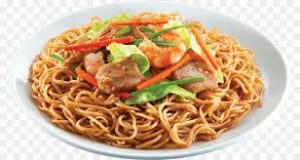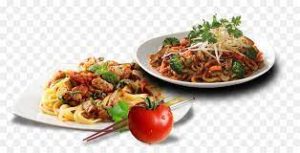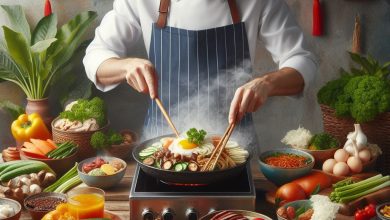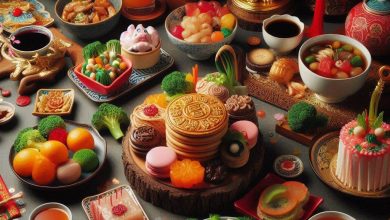Culinary Symphony: A Journey Through the Diversity of Chinese Cuisine
Chinese Cuisine

Introduction:
Chinese food is renowned for its long history, wide range of flavors, and skillful preparation. It is a reflection of the nation’s cultural legacy and geographic variety. Chinese cuisine has developed over thousands of years, shaped by regional variances and resulting in a complex and nuanced tapestry of tastes and methods. This article takes the reader on a gourmet tour of the rich and varied world of Chinese food, delving into its fundamental ideas, essential components, signature recipes, and cultural relevance.
Foundational Principles of Chinese Cuisine:
The preparation and presentation of Chinese food are influenced by a number of fundamental ideas. The harmonic balance of tastes, textures, and colors reflected in these guidelines adds to the overall eating experience.
- Five Flavors (Wu Xing): The harmony of the five basic flavors—sweet, sour, salty, bitter, and umami—defines Chinese food. The goal of the skillful blending of various flavors in one dish or across a meal is to create a palate-pleasing symphony.
- Yin and Yang: Chinese cuisine is based on the idea of Yin and Yang, which stands for the harmony of conflicting forces. This harmony is evident in the flavors of a meal as well as in the choice of components, preparation techniques, and overall dish structure.
Key Ingredients in Chinese Cuisine:
The wide range of ingredients that make up the foundation of Chinese cuisine are a result of China’s unique geography, which includes a varied terrain and climate.
- Rice and Noodles: Rice and noodles are mainstays in the Chinese cuisine and serve as the basis for a lot of dishes. The wide variety of Chinese cuisine may be attributed to the adaptability of rice and the variety of noodles available, ranging from thin and delicate to thick and filling.
- Soy Sauce and Fermented Products: Chinese cuisine uses soy sauce, a fermented condiment comprised of soybeans, wheat, salt, and water, extensively to improve taste. Soybean paste, oyster sauce, and black bean sauce are examples of fermented items that provide a wide range of meals depth and complexity.
- Fresh Vegetables and Herbs: The use of fresh vegetables and herbs is a hallmark of Chinese cooking. The use of colorful and fragrant plant-based items enhances the nutritional content and visual appeal of meals. Examples of such ingredients are green onions, cilantro, and bok choy and Chinese broccoli.


Iconic Chinese Dishes:
- Peking Duck: Imperial in origin, Peking Duck is known for its crispy skin and tender flesh. After seasoning, the duck is air-dried and then roasted until the skin crisps up. Traditionally, customers can put up their own wraps with thin pancakes, hoisin sauce, and sliced green onions.
- Dim Sum: Small plates or steamer baskets filled with bite-sized amounts of food are known as dim sum, and they are a famous Cantonese culinary style. Dim Sum is a broad category that includes many different foods, such as buns, dumplings, and miniature pastries, and it provides a fascinating and varied dining experience.
- Kung Pao Chicken: Sichuan province is home to the spicy and tasty cuisine Kung Pao Chicken, which is made with chopped chicken, peanuts, veggies, and chili peppers. The dish’s harmony of salty, spicy, and sweet ingredients is well-known.
Regional Diversity in Chinese Cuisine:
Due to its enormous size and geographical variety, China is home to a diverse array of culinary traditions, each with distinctive traits and delicacies of its own.
- Cantonese Cuisine: Cantonese food, which originated in the province of Guangdong, is renowned for emphasizing delicate tastes and fresh ingredients. Common cooking techniques include roasting, stir-frying, and steaming. The best things about Cantonese food are the dim sum, roast meats, and seafood dishes.
- Sichuan Cuisine: Sichuan food is well known for its strong, piquant tastes. Sichuan peppercorns are used to provide a unique flavor profile and numbing feeling. Sichuan cuisine is powerful and vigorous, as seen by dishes like Mapo Tofu and Sichuan Hot Pot.


Conclusion:
In summary, Chinese food is a gastronomic symphony that harmonizes a wide range of tastes, textures, and preparation methods over a sizable and culturally varied region. Chinese cuisine is defined by the diverse range of regions that contribute to its culinary mosaic, ranging from the imperial kitchens of Peking Duck to the fiery kitchens of Sichuan. Chinese culinary traditions are characterized by a symbiotic relationship between balance, a vast array of ingredients, and the cultural significance of food. These elements have left a culinary heritage that has captivated and inspired food fans worldwide. We embark on a voyage through history, culture, and the lasting spirit of a culinary tradition that transcends time and countries as we relish the many flavors of Chinese food.





